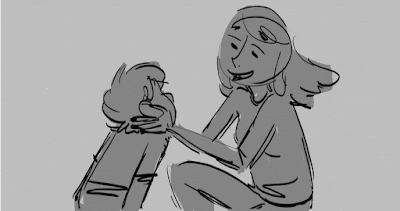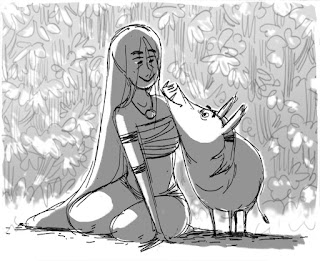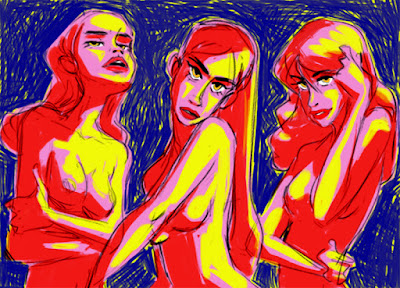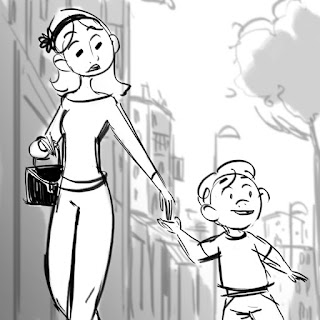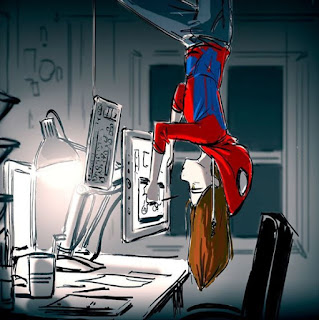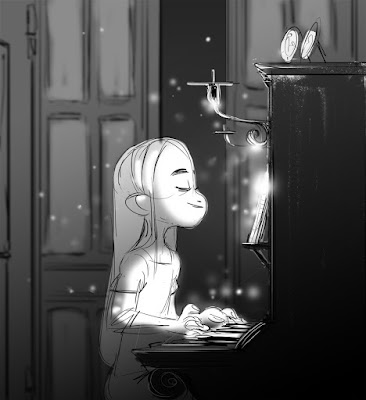Friday, March 30, 2018
VFX Workflow, Part 1: Layout and Planning
With the rise in popularity of fantasy and sci-fi films comes a huge surge in demand for VFX. AnimSchool instructor Tony Mecca has worked in the forefront of the VFX industry for several years, animating for films like Snow White and the Huntsman, RIPD, and X-Men: Days of Future Past. Tony has a particular workflow for VFX, which centers around a “splocking” method that is designed to produce smooth, realistic animation as quickly as possible in VFX shots, which are typically too heavy to have real-time playback. This workflow starts out in spline/auto tangents right away, and can be used for full-CG shots as well. In this demo, Tony utilizes his “splocking” workflow to animate a shot of a monster running and jumping off of a ledge, using AnimSchool’s Hellhound rig.
Part 1 covers the layout and planning phase, and Part 2 will cover the posing and overlap phase of the demo. (View Part 2 here)
Looking for the best 3D Animation schools? For more information about AnimSchool and our online animation programs, visit us at www.animschool.com
Friday, March 23, 2018
3D Animation Interview: Sony Pictures Story Artist Eva Bruschi
Welcome Eva Bruschi, Storyboard Artist for Sony Pictures Animation! Could you tell us about yourself, your career and how you became a Story Artist at Sony ?
Of course :) My name is Eva and I'm Italian, born in Tuscany 34 years ago (almost 35) and about myself and how it all "started", well, I remember that as a kid I was always ready to solve situations by drawing something, because I loved drawing and liked to help.
One day - probably I was around 4-5 years old - my grandma needed celery and I drew a bunch of celery for her recipe. I though that was the same as having real celery for cooking, it was green and looked like celery so was enough for helping her. My mom was often missing the beach during winter time so one day I drew the sea, the sand, a blue stripe for the sky and the yellow sun, probably a crab walking and a boat floating far on the horizon, there certainly was even a seagull.. and then I gave her the drawing. "You can hear the waves if you get closer, mom, so now the beach is nearer and you shouldn't miss it so much!"
The rest of the time I used to draw for myself (when everyone was done with my presents).
It's really common among kids to give drawings as gifts thus I was perfectly acting as everyone, maybe I just kept doing it for a longer time than everyone.
I was actually always drawing, literally everywhere, the walls of my house were also filled with my drawings because my parents made the great mistake one day to say : "okay, you can draw on the walls but don't go out of your bedroom space".
Didn't work and I ended up covering the rest of the house.
C'mon. How can you resist to those big, white and empty walls?? My graffiti remained there for many years and as I grew up was nice to see the crazyness yet the truth that's in kids drawings.
I remember I loved to draw houses and gardens, well detailed gardens and animals. Cats and cows in particular. I remember while I was spending time with grandparents, my grandma used to tell me about her youth spent among the mountains, since she was Swiss. I often drew something out of those stories.. that's probably where the many cows came from.. and probably even my first storyboards panels!! :D
I was also fascinated by bugs, so I used to often draw them. I knew them pretty well because for one birthday I received a microscope as a gift, so I soon became the nightmare for all the small creatures around in the back yard because I wanted to see if bees were wearing underpants. Anyway, looking in there, through the lens, was like looking through the window of another world, another dimension.
I was drawing and drawing and drawing and I never could get enough of that!
I drew until the end of secondary school, then thought I couldn't survive nor pay for a rent with only drawing, so I followed a technical high school (and discovered photography, still another great passion of mine beside playing a bit on the guitar) and wanted to become a mechanic! But if there's something in you that you really can't hold, one time it comes out again, I promise.
So this happened. I was 23 and after I gave engineering a try at university,
I decided to attended an art school here in Italy. A 3-year animation course. School was pretty expensive for me so I was working while attending classes. I remember one day, during a workshop, an external teacher told me something like "hey you can't do this as a job and still have another job to maintain you.
You should only draw, all day! You're not gonna make it this way, you probably don't want it for real, to become an artist and make a living out of it". That was a terrible day, one of the worst for me, but I knew that from that moment on, I wanted to become good at drawing and a professional even more.
After school - where they destroyed all my confidence in drawing and made me re-mold it - I started collaborating freelance with very talented people, mentors from whom to learn everyday, all the time, for Italian television series and features as story artist, but also as a 2d layout artist or 2d animation assistant. Especially in the beginning I had to take on everything that came by, not only storyboard work, because I needed a job and earn some money to keep living.
So without having the chance to choose the project I liked the most, I did learn much anyway.
At the end of 2014 I was contacted on LinkedIn (holy LinkedIn, get a LinkedIn profile guys and keep it updated!!!) and I was asked to help on a project as a freelance story artist (project was "High In The Clouds"). From that moment on, I have to say that my life has gone through many changes.
After that year and a half I spent boarding on that, I got to know many kind, professional and talented people who trusted me - and I guess that is the main point - and liked my work. So from one project to another, I luckily found myself working for Sony Pictures Animation. Ta-Daa!
What a beautiful story!
Can you tell us what a Storyboard Artist does?
Preproduction is where things get real for the first time and is great, to me, because you can play with a bunch of different aspects together. As a storyboard artist, you work in this phase and basically translate the script into drawings, so from words to images.
To do this, you need to know about acting, figure drawing, perspective, cinematography.. playing with lights in a scene is also really important if, for example, you're showing a particular moment rich of emotion or a moment that someway has to be underlined. You have to understand what the script really says and have to start imagining what's going on, then put it down on paper (or PS layers). This also includes other ideas (extra-script) that you came up with and that you will pitch later, like adding gags and reactions, giving it a certain energy that maybe not be described in the script.
You also have to be extremely flexible, giving more (and more, and more, and more...) versions of the same sequence if required without getting crazy or depressed (just joking:). You have to take notes and modify what has to be changed. Be able to listen to directors and their ideas of the show and as said before, you have to be able to pitch your own ideas!
Everything comes with time and experience (I'm talking to myself here!) and it's not only about drawing, but also about patience and the willingness to do what's best for the project.
So in the end, a story artist is in charge to give the first visual breath of life to a story, which as a thought to keep in mind, pays you back for all the sequences they cut you.
Can you use your own style of drawing or is there a certain in-house style of story boarding?
I'm quite free to use my own style in terms of drawing but of course you have to stay close to the models, their proportions on the screen and the right amount of energy to give to a scene that has to hook up to what's before and after in the movie. What has helped me to get to know the style, if there's any, was watching at other story artists work on the project. Comparing styles and ways of solving scenes is always a good thing that gives you the chance to get inspired and learn something.
Have you done 2D or 3D animations yourself? Or are you planning to make some?
I did 2d animation especially when I was at the art school, but I find animation always fun to experiment.
I need some free-time to animate tho, so it's often hard to start something and finish it
But from time to time I try.
Looking for the best 3D Animation schools? For more information about AnimSchool and our online animation programs, visit us at www.animschool.com
Do you have any tips for applying for a job at a main studio, such as Sony Pictures? In respect of demo reel or presentation, where to present your work ( like a website or Social Media)?
You've got to prepare a good porfolio/demoreel for sure- first things you show should be your best, so that they want to see more - then distribute the other good things in the middle and at the end to maintain a high level of interest and attention. Then with your super product in your backpack, you should travel a bit around animation exhibitions all over Europe and USA (to mention two of the most relevant, Annecy and CTNExpo), and book an interview (or just wait in line for your turn) with your favorite studios who have a stand there. Even if nothing relevant happens from the first round (in terms of hiring), you surely got to know many incredible artists and you have a crazy experience to share.
I didn't know anything about all this when I started, but it might be a tip.
I think that having an account, a social platform or a website and keeping it updated, makes a big difference nowadays. Everyone can see your work this way (and maybe even wants to hire you!). This way you can get in touch with the best artists, knowing them for example from what they do and draw or paint in their spare time.
You're able to show what you've worked on. And it's also a good way to compare your work to other artist's work.
It makes you improve your skills and motivates you to always do better. You can learn every day from each single artist. That's what Instagram has given me and still does.
Being part of a major production company, how does that affect your artistic creativity?
As an inspiration. To be at my best, all the time. Honestly, I've always tried to give all I've got in every work I've done. I always give all of my heart and use everything that I have learned to every new production I've joined. I think this has helped me a lot, because this way your attention goes to everything and this makes you improve. Doesn't matter how big and famous the production you're working for is, if you love what you're doing you'll always give all you've got.
I'm really passionate about working for Sony Pictures Animation.
It has happened in the past that I had to work with people that didn't care that much. Nothing is more frustrating, because we all know this is a job that you do out of passion. As time goes by you learn to recognize those situations that require less heart, but it's always a shame to give less, so if you can choose, choose what gives you good vibes and put all that you have into it!
Who do you work with when you work on a story? Directors, scenario writers, the animators, layout artists etc.?
As a freelance, I collaborate with the directors.
I have meetings with them for assignments, notes and pitches.
Can you talk about the production you are currently working on?
"Spider-man: Into the Spider-verse"
I'm not allowed to show anything yet! You have to sign an NDA so you won't ruin the surprise :)
But you can check the trailer that's on line, I promise the movie will be fantastic!!
I've got pretty used to not being allowed to show my work. That's probably why I post my doodles on Instagram!
Can you name a few people that have been a big inspiration to you?
Louie Del Carmen, Darren Webb, Normand Lemay..
And I could keep going with names, there's plenty of awesome different artists around, of course not only story artists! But they're always a big reference, especially if one day I feel not at my best to draw - and it does happen. But that day you have to keep working anyway, so I often go to their blogs/Instagram or whatever there's on the internet and I stare a bit at the perfection of their art, I kinda treat my eyes.
I could say they're my happy place where I recharge!
What inspires me is also an old sketch of a small town square with a fountain and some birds flying over. I remember it was hanging on my grandparents wall, in the hallway. I always asked for it when I was a kid, because I wanted to copy it. Black ink on white paper. So simple yet so strong. Never discovered the name of the artist.
But I also get inspiration from people who are not in the industry of course. I usually get inspiration from everything that surrounds me. Drawing is important, but also what you do in your free time, the people you hang out with, the places you see.. all this have their weight on your work and sometimes it brings you a lot of unexpected cool solutions!
Have you been a teacher/ guest teacher or do you consider teaching one day (passing on your experience) ? And what other goals do you have in the animation business besides story artist ?
Never been a teacher. Who knows, maybe in the future? I'm pretty shy and everything intimidates me at first, especially because I've got a strong self criticism and I feel like I still have got a long way to go before I can give advise and speak some wise words!
The again it's said that teaching gives you a lot, as a person and as an artist and I kinda believe that, so let's see how things evolve!
No other goals for now in the animation business. I mean, I'm a freelance so it's a bit different working from home, than being in the studio where you can build your career. I can say I've always liked to work for music videos, creating a story out of a music track. You already have the timing and music gives you the inspiration, the path, so yeah, that would be interesting to do, directing and drawing for music videos! Here you have my goal :)
Thank you so much for your time and your joyful insights of being a storyboard artist, Eva. Finally, do you have some advise for us, students of Animschool?
Well...Don't cook paper celery!! The green pastel has a terrible flavor. :D
But seriously, I've learned not to be concerned of what I draw, as well as to throw my drawings away if they weren't working. I learned the basics of anatomy then forgot them again to make room to learn other things (then luckily re-introduced them :D).
I mean, I discovered that it doesn't really matter if a character posture is not completely correct while you do storyboards. That will come with time and practice. Problem comes if you only focus on how much you don't like the drawing and you get stuck there, and I share this because that was one of my main concerns when I started.
The important thing is to be simple, focusing on the acting, expression and attitude of your character, putting it in a clear scene with an interesting point of view and a nice light.
You're already telling something if all these things are present in a panel, no matter if it's a sphere on the ground smiling at a beautiful spring day.
Thank you Eva, for an inspirational interview and good luck with working on your current project!
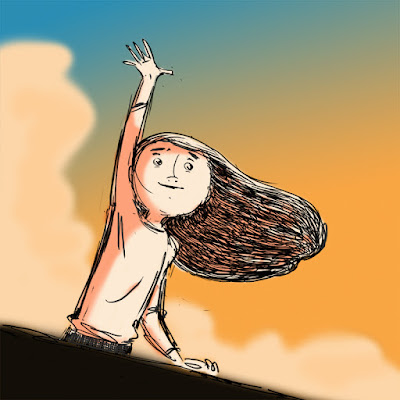 |
| All drawings by Eva Bruschi |
Looking for the best 3D Animation schools? For more information about AnimSchool and our online animation programs, visit us at www.animschool.com
Thursday, March 8, 2018
Interviews with "Here's The Plan" Animators (part 3, Francisco Anabalón)
Since its release in April last year, Here’s the Plan has received acclaim for its realistic portrayal of the hardships of relationships, as well as its bright and pleasing art style. This 18-minute “short” was animated by a hard-working team of 5 animators, many of whom are or were students here at AnimSchool. I had the great pleasure of interviewing them on their work on Here’s the Plan, and I’m excited to share what they had to say. Last, but not least, we have an interview with Francisco Anabalón, who is a current student at AnimSchool.
Please tell us a little bit about yourself.
Hi! I´m Francisco Anabalón, I´m a Digital Animator currently finishing the Animation Program at AnimSchool, from Santiago de Chile. Before enrolling in AnimSchool, I studied drawing at an art program of a local University and then Digital Animation, after that I worked 2 years as a freelance character animator and then I decided to study here at AnimSchool. Besides animation, I really like life drawing ( https://www.facebook.com/FranciscoAnabalonArt/) and play guitar!
How did you find out about “Here’s the Plan”, and what drove you to work on it?
Fernanda Frick and I were classmates during the first year of my studies in Digital Animation. She left the school, but we were still meeting at animation events. When she won funding for her film on the Chile´s National Council of Culture and Arts, I was working on commercials and tv series, but I wanted to work on something more challenging in artistic terms. I met her at an animation festival and likely she was looking for character animators at the time, so she agreed to work with me when I asked her.
What is your favorite aspect of the film?
I think the art direction and all the CG aesthetic achieved is really cool and original. I also like the camera work, the cinematography. In terms of animation, there are really good shots, I wish we had more time to do stronger character animation on the whole movie - I think that was the most difficult part to achieve with the funds and the time Fernanda had.
What were some of the hardships of working on a short film?
The most difficult part for me was the time we had to finish the shots. I really wanted to do the best animation I could, so at the beginning I did it as well as I could even knowing that, by taking longer, it meant I would have a lower wage at the end of the month (the Council of Culture and Arts pays by "animated second” - that isn’t much) but in the end, taking too long wasn´t possible because of the deadline. It was stressful for me on that aspect, probably because I hadn’t had a similar experience before.
Were there things you learned during your classes at AnimSchool that you applied to your animation?
I enrolled in AnimSchool after finishing “Here’s the Plan”, but I had two mates there that had done the Animation Program in AnimSchool when we were on the production (Maikoe Alaniz and María José Venegas). I was really impressed by their work and they recommend me the school, so I decided to study here. I wish I could take my shots back and do it them again with all that I´ve learned here. Many things that I thought I knew I realized I didn’t understand well until I saw the way my instructors approached them - for example, understanding how to depict proper weight to a bouncing ball through the highs and lows, or acting tips like avoiding generic breakdowns in your animation, body mechanics for something I didn't have much practice with, a deeper thought of the subtext of my acting choices, etc. I also think I have a better workflow now; this isn´t a rule, but an instructor taught us how to start with a pass with keys on all controls and then to offset them in groups when you pass to spline, and that helped me a lot to keep control on the movements until the polish. I think all these things would’ve helped me when I was animating on Here’s the Plan.
I´ve had a really good experience studying at AnimSchool, we have all these great industry pro instructors who critique your work for the whole course, and you learn all the principles, tips and workflow from them on the lectures. Also, the student community is very friendly and supporting, following the progress of your classmates it´s super motivating!
What is a shot you worked on that you’re particularly proud of? What was effective about it?
The shots that are on my demo reel are the ones I like the most ( https://vimeo.com/61929026 ) the style that Fernanda wanted was really subtle (not much stretch and squash, overlap...) but I think on their simplicity they communicate well the intentions of the characters.
Tell us about your workflow for animating a new shot. (Vid ref or drawings, how much goes into your blocking pass, whether you start in spline right away, use of tools/plug-ins, how you polish, how you implement director feedback)
Fernanda did this video with a shot of mine that shows my workflow: ( https://vimeo.com/254337202 ) I also used video reference on this and on most of the most important shots. I started working in stepped until I finished the breakdowns, but then I realized that working directly on spline was quicker, so I ended up doing just the main poses in stepped and then passed to spline right away. One important thing on my workflow was to be careful of keying the important poses and have everything in order before showing it, because Fernanda wasn´t approving everything at the first try (this may seem obvious for people working on big productions, but the commercials and tv series that I worked on tended to had few changes). Fernanda and Maikoe taught me how to used “Tween Machine” and “Arc Tracker”, I showed my animations and asked my doubts to both of them while I worked because they knew a lot more than me, they were really generous with their feedback and that was really useful to improve my workflow and the animation.
What advice do you have for students/grads looking to work on short films or freelance projects?
I think it is really good to do these kinds of projects to improve your portfolio and gain experience, I learnt a lot and met awesome people. It was also really cool seeing the project go so well. If you have the chance, it could be a really enriching experience! I believe is very important to go to festivals or animation events because they are great opportunities to network in person. Deciding to work with someone has a lot to do with knowing him or hearing of him- seeing an email with a good demo reel isn’t a guarantee that you are someone that can be trusted, and people consider people that are present for them to recommend or hire. Besides, it’s really fun! I love those events, I go to all I can.
Lastly, you said that you worked on TV shows and commercials before working on Here's the Plan. What are some differences between working for TV and working for a short film? And, what were the pros and cons of both for you?
I think tv series look for a medium quality animation that you can create as fast as you can- there is no time to do many explorations. It is good for practicing animation principles, and generally are large projects so it is more stable than commercials. For me the cons is that you tend to win more if you are faster, not necessarily if you achieve better quality.
Commercials are generally better paid than TV series, but they are unstable - many animators learn other things to stay on one place (like rigging, modeling..), Also, I think it is difficult to learn acting doing them because you are not telling a story in a strict sense.
In my experience with Here’s the Plan, I had the chance to explore acting more in depth than in my previous jobs. It was also very different to work for the vision of Fernanda. Her short film was so important to her and she had an artistic vision, she wanted to tell something with it, and sometimes I had to re-do something because “that wasn’t the kind of relationship the couple had,” for example. That is really cool and it’s the kind of artistic task that I want to work on. The cons in this case was that there were no much money to do it, I couldn´t work permanently on a job like that. I think working on bigger projects with that standard would be really cool, I hope I´ll be able to do that with what I´ve been learning with AnimSchool.
Thank you so much, Francisco!
Looking for the best 3D Animation schools? For more information about AnimSchool and our online animation programs, visit us at www.animschool.com
Subscribe to:
Posts (Atom)




